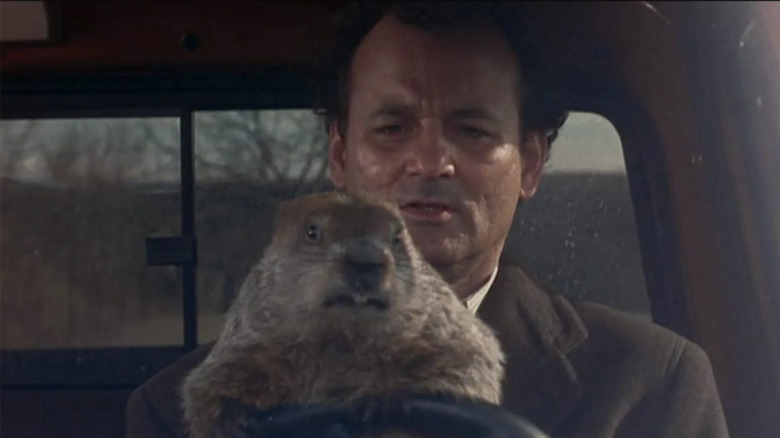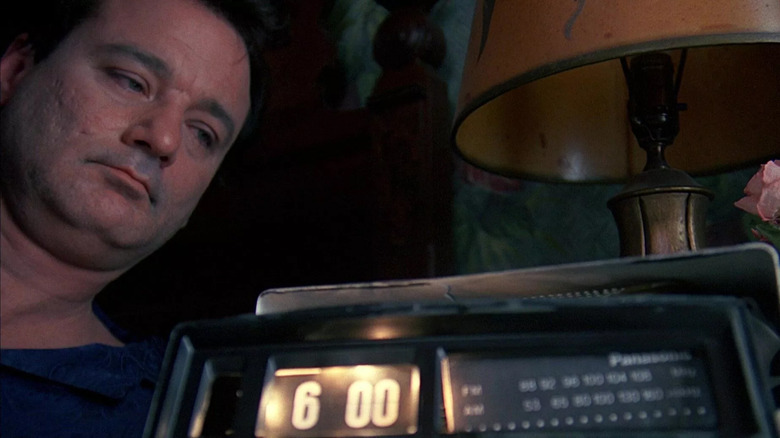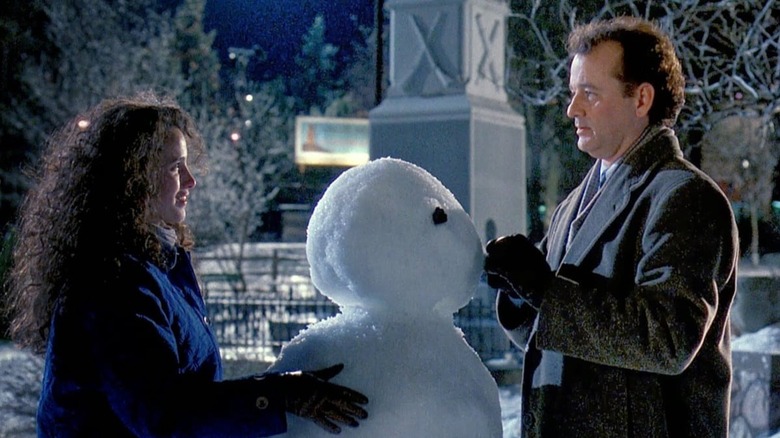Groundhog Day's Biggest Mystery Never Had An Answer
One of the most beguiling aspects of 1993's "Groundhog Day" is the way Phil Connors (Bill Murray) becomes trapped inside a time loop, the rules of which are never entirely explained. While the film works brilliantly as a comedy and character study of the arrogant and self-centered Connors learning how to be a better man, Phil learns those lessons by literally being left to his own devices, struggling through trial and error to stop living through February 2 over and over again.
Part of the conceit of the film is that Phil is trapped in the same day for long enough to not only be able to change his ways but also learn how to do things like play the piano, sculpt ice, and memorize the movements (and other details) of the people around him in Punxsutawney, Pennsylvania. His ability to do all this naturally makes us wonder: Exactly how long did Phil stay in that time loop for? It's a mystery the film leaves deliberately unanswered, but this isn't a case of director Harold Ramis and writer Danny Rubin holding information back. The answer never existed.
It's gonna be cold, it's gonna be gray and it's gonna last him for the rest of his life...approximately
As Rubin explained to The Ringer in 2017, the time loop in "Groundhog Day" was never intended to be concrete or easily defined, but rather "an experiment to see what would happen if a person had more than one lifetime. Would that be enough for them to grow up?" While that notion seems to imply a story about someone becoming immortal, Rubin conceived the plight of Phil Connors as "having an infinity of days in a circle, as opposed to in a line," and that allowed the writer to realize that Phil's transformation "didn't have to actually have a specific number of days."
When Ramis came on board to work on the script with Rubin and present the concept to the studio, Columbia Pictures, the people at the top apparently "couldn't hack this length of time" idea. Thinking audiences would become too confused and frustrated if the timeline were left vague, the studio demanded that Rubin and Ramis establish the events of the movie taking place over approximately two weeks. The co-writers were firmly against the idea, stating that "there's no way it's a credible adventure in two weeks."
In the end, Ramis solved the problem in the most elegant way possible: avoiding it altogether. He removed any and all references to how long Phil repeats Groundhog Day, making it "so that anyone can use their imagination," as Rubin put it.
'Anything different is good'
Just because Rubin and Ramis never made a point of stating the exact length of time it takes Phil to advance toward February 3 doesn't mean they didn't have their own perspectives on the matter. As Rubin recalled, "Harold gauged it at about 10 years," while Rubin himself simply believed that "it needed to be more than one lifetime." However, the writer emphasizes that the life span of the dharma as found in Buddhism, about 10,000 years, "would be too long."
Yet the question is still debated in numerous corners of the internet, and Ramis himself even re-thought his initial answer of 10 years. Speaking to Heeb Magazine in response to this blog (which claimed Phil's time loop lasted 8 years, 8 months and 16 days), Ramis said he thought, "The 10-year estimate is too short. It takes at least 10 years to get good at anything, and allotting for the down time and misguided years he spent, it had to be more like 30 or 40 years."
Of course, Ramis summed it all up by observing that "people have way too much time on their hands. They could be learning to play the piano or speak French or sculpt ice..." Phil Connors was eventually freed from his plight by learning to accept all that he couldn't control and didn't know, and fans of "Groundhog Day" would do well to learn that lesson.


